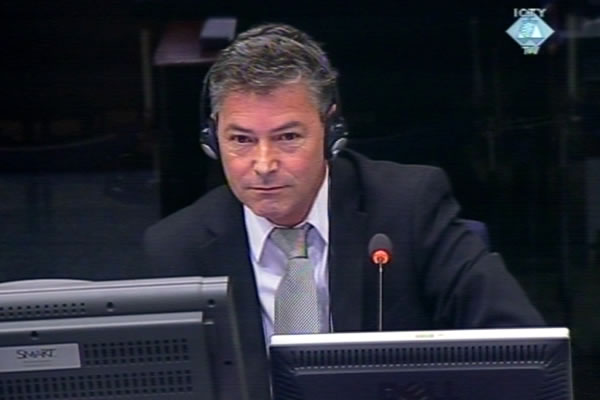Home
RECONSTRUCTING THE CRIMES IN SREBRENICA
French inspector Jean-Rene Ruez, former head of the OTP Srebrenica investigation team, continued his evidence at the trial of Republika Srpska president Radovan Karadzic. Using maps, photos, aerial images and videos, Ruez began his reconstruction of the events in the Srebrenica enclave after the arrival of Mladic’s troops in July 1995
 Jean-Rene Ruez, witness at the Radovan Karadzic trial
Jean-Rene Ruez, witness at the Radovan Karadzic trial In 1996, French inspector and former head of the OTP Srebrenica investigation team Jean-Rene Ruez visited all the sites vital for the reconstruction of the events in the Srebrenica enclave in July 1995; he was following the trail based on the information obtained from the survivors. In the years that followed, Ruez revisited many of these sites, reconstructing the Srebrenica crimes puzzle, piece by piece.
In the examination-in chief, Ruez marked on the maps the key directions in which the people moved on 11 July 1995: towards the UN base in Potocari where most of them sought salvation, towards Susnjare and further on towards Tuzla; this is where a column of about 15,000 men was headed. Ruez also noted the locations where men were separated from the rest of the population, detention facilities, the sites where men were executed and the mass graves. All the stages of the investigation were recorded in detail on the photos and videos shown in the courtroom.
By the end of 13 July 1995, the Serb forces completed the deportation of the people from the enclave and captured the men, who were detained at various locations such as the ‘white house’ in Potocari, the primary school in Luke, the football stadium in Nova Kasaba, the Kravica warehouse, and the hangar and other facilities in Bratunac. According to the witness, there were so many prisoners in Bratunac that it was impossible not to notice them. Every resident of the town had to have known about them, including Miroslav Deronjic, Karadzic’s ‘civil affairs commissioner’ for Srebrenica. Deronjic’s office was located ‘in the thick of things’.
Karadzic has repeatedly tried to distance himself from Deronjic, claiming that they were on ‘cold and distant’ terms: they were in fact ‘political adversaries’, he has said. Deronjic pleaded guilty to the murder and deportation of Muslim civilians from Glogova and was sentenced to 10 years in prison. In May 2005, Deronjic died while serving his sentence in a prison in Sweden.
Ruez then described the next stage of the Srebrenica investigation, identifying the mass execution sites and graves where the victims were buried. The mass graves in the Cerska valley and on the bank of a small river called Jadar were discovered thanks to the information obtained from the survivors, Ruez recounted. 151 bodies were exhumed from the Cerska valley grave and about 60 bodies were recovered from the Jadar river bank. Using maps, photos and videos, the witness reconstructed the massacre in the warehouse in Kravica and at two execution sites near Orahovac, where two mass graves, named Lazete 1 and 2, were exhumed.
Jean-Rene Ruez continues his evidence on Monday, 30 January 2012. After his examination-in-chief, the prosecution will call William Haglund, American anthropologist who was in charge of the forensic team working on the OTP investigations in Srebrenica from 1996 to 1998. After Haglund’s evidence, Ruez will return to the witness stand to be cross-examined by Radovan Karadzic.
Linked Reports
- Case : Karadzic
- 2012-01-26 KARADZIC FALLS BACK ON SUNSHINE AND SHADOWS IN HIS DEFENSE
- 2012-01-25 ON TRAIL OF PIROCANAC’S SREBRENICA VIDEOS
- 2012-01-24 YEARS OF HUNGER AND DEATH IN SREBRENICA
- 2012-01-30 BADLY ELIMINATED TRACES OF CRIME
- 2012-01-31 KARADZIC: MASS GRAVES WERE THE RESULT OF TERRAIN CLEAR-UP
- 2012-02-01 RUEZ: ONLY ‘VICTIMS OF EXTERMINATION’ WERE BURIED IN MASS GRAVES
